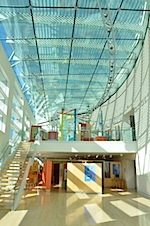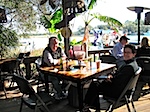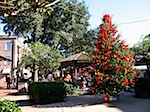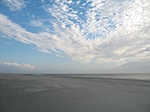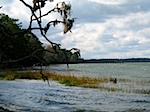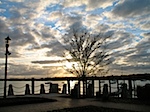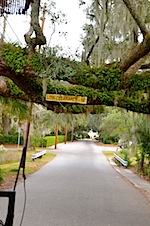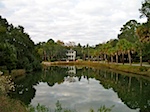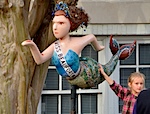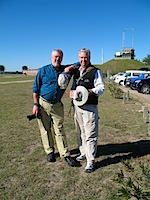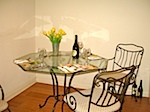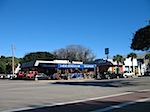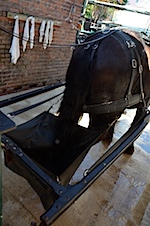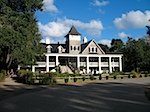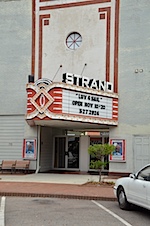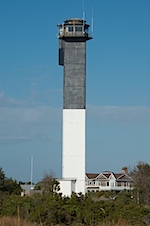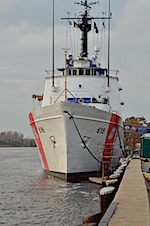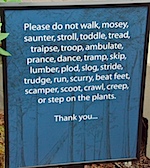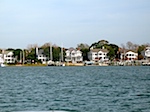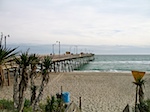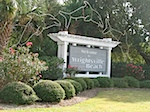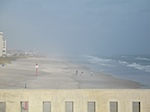South from Savanah
Taking leave of the pleasures and mysteries of Savannah, we headed for Jekyll Island for a visit with my cousin Martha and her husband Russell. As we were slightly early we detoured across the river to Brunswick, Georgia, which is a thoroughly charming little town. They built dozens of Liberty Ships there during WWII; there is a huge paper mill upriver and a big terminal for the automobile carriers (RORO (roll-on, roll-off) ships) bring ing imported cars from Europe. Brunswick had the usual quotient of huge live oaks lining the streets, and on a number of streets, the trees were taking up a whole lane and the road simply ran around them; very nice to see that the town respected the elders of the area.
Jekyll Island is across a 6-mile long causeway and when you reach it you have to pay a $ 5 “parking fee” to Jekyll island State Park; the whole place is owned by the State of Georgia as far as we can tell; homeowners lease the land under their houses from the state. It has a very curious and interesting history of which we knew nothing at all. Marty took us to lunch at the the gorgeous, and rather time-out-of-mind 1880’s resort and conference hotel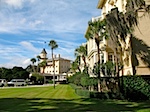 and we had a wonderful time catching up on family and friends; we toured the rest of the island in the rain before leaving. Marty loves the island for its out-of-time, unchanging quality, and it did indeed feel special in a less Stepford way than Hilton Head.
and we had a wonderful time catching up on family and friends; we toured the rest of the island in the rain before leaving. Marty loves the island for its out-of-time, unchanging quality, and it did indeed feel special in a less Stepford way than Hilton Head.
Crossing into Florida, we did our usual drill of stopping at the Visitor Bureau where we were supplied with the basics of a good state highway map (remember the ones you used to get at any gas station? You have to go to Visitor Information now to get them, and it’s worth it). We got a reservation on Amelia island, near Fernandina Beach and had a very good dinner in the historic district of Fernandina Beach (first restaurant we’ve been to since Virginia with people wearing blazers; too many New Englanders living down here…). Gorgeous little town, with a railroad running into it, a container port, and the requisite paper/pulp mill; an industrial waterfront lying between the lovely downtown and the river.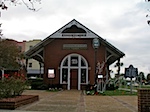
Woke Thursday to cold, blowing, grey weather rolling into our beach front lodging, so we bailed out and headed down the A1A. We ran through a series of gorgeous state parks lying on the swampy peninsula between Amelia Island and Mayport: beautiful area, with lots of protected land and beach, and took a ferry across to Mayport. It turns out (perhaps you all knew this) that Mayport is a MAJOR naval base and silhouettes of carriers, cruisers and destroyers loomed on the horizon. Still, there seemed to be an unusual number of CG, police and patrol boats in the river, and beady-eyed cops examining us as we drove off the ferry at Mayport. Turns out Joe Biden was visiting a high school south on Mayport on route A1A, and only a timely warning from the ferry staff and a park staffer at a local park we visited prevented us from driving right smack into a Department of Homeland Security nightmare: can you picture us having to empty the car, with Swiss driving licenses, a Maine car, no visible means of support, binoculars, cameras with long telephotos and coming out of it in less than 48 hours w/o going to jail thanks to the DHS, who are protecting the US of A from terrorists……?
We were told how to detour, and detour we did, down the A1A again, stopping in to St. Augustine to see the “oldest inhabited city in the US”. There is reason to visit the place as the history is interesting, but it is also hard to appreciate it through the fog of tacky commercial development and a style of welcome which sets your teeth on edge. Charleston and Savannah seem to have managed to preserve a sense of the feel and appearance of their history in such a way as to make it accessible and enjoyable; St. Augustine needs to study its neighbors accomplishments.
We thought we might stay in St. A. for the night, but it was too egregiously touristy, so we drove through some amazing beach scenery and ended up in Daytona Beach. Picture high rises that would put Monte Carlo and Tenerife’s Playa de los Americanos to shame. Anyone who knows what DB is famous for can surely appreciate that it’s a beach strip of an er, ah, specialized sort. But today being Dan’s birthday we thought we should spend it in an unusual setting so here we are in a comfy 10-story beachfront hotel. The real charm of it is that they offer you a bag of marshmallows with the room which you can take downstairs and in return for a $10 bill get some graham crackers, chocolate and forks and make smores over a fire out on the terrace overlooking the beach. Did we take them up on it? You take a guess.
The A1A is the beach strip highway and traveling on it has rewards and drawbacks. The drawbacks are that you get to see the good, the bad and the ugly; the bad and the ugly are common to nearly all commercially developed beach strips. The good is that you find state parks, long stretches of open beach, seabirds and storks, dunes and sea oats, little to no traffic, easy parking and plenty of choice of places to stay.
The country between Jacksonville and the ocean has an astonishing number of creeks, estuaries rivers and bays. It looks like the work of a lifetime to get to know such waters. Click on the thumbnail to see the large image, or go to Google Earth or Google Maps and see for yourself. We are a little worried about what we will find the next two hundred miles down the coast. Not sure we will find Everyman’s good land. More to follow…
